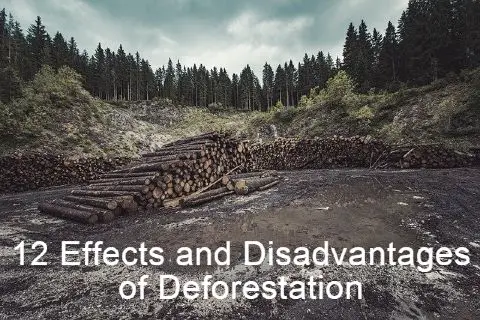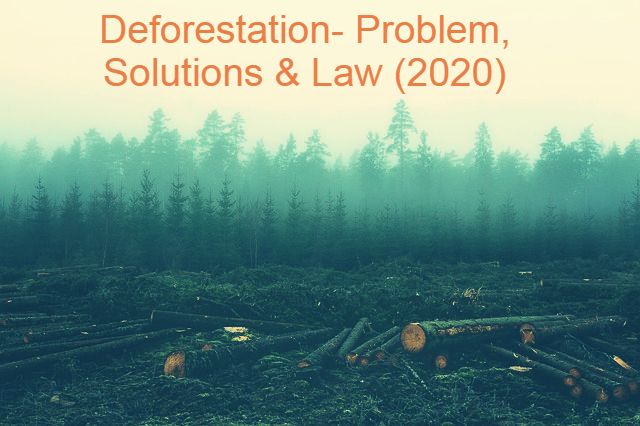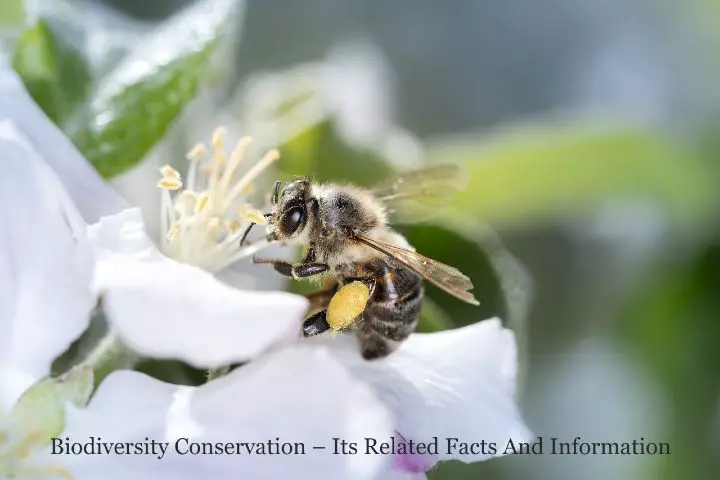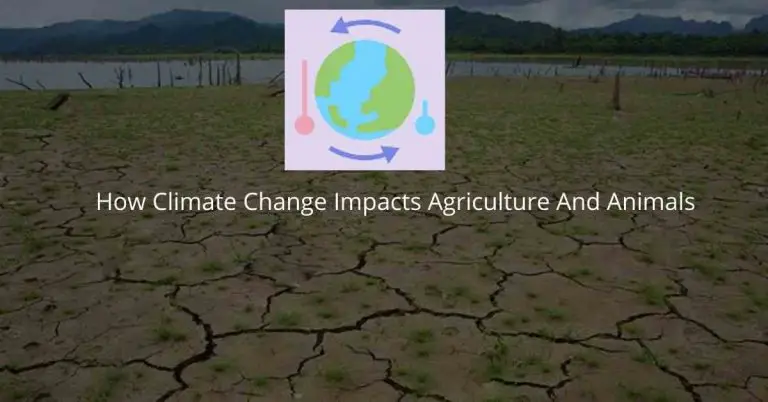What is Deforestation? Causes, Effects & Solutions
Forests have been an integral part of human life since ancient times. They have indeed been beneficial to human life. They help bring rain and increase the fertile power of the earth. Forests are capable of preventing flood risk by absorbing rainwater. The forests absorb the water and slowly carry it into the atmosphere. Forests prevent land degradation, help eliminate drought and check the spread of deserts.
As civilization evolved, humans began cutting down trees to meet their needs. Deforestation continued in this way and it had a profound impact on the environment. Today, in the blind race of development in the world, forests are being reduced rapidly due to which the balance of the environment is deteriorating and the threat to the existence of life on earth is increasing.
What is deforestation?
Forests are a wide area that completely covers trees that improve the overall biological potential of the environment. Trees play a larger role in carrying environmental balance than any other component of nature. They play a silent but preservative role in promoting the useful elements for nurturing life.

Trees and flora guard us in opposition to worldwide global warming by absorbing excess and harmful carbon dioxide from the environment. In one year, an acre of planted trees absorbs as much carbon as a car produces carbon over a distance of 26,000 miles.
Deforestation occurs when forests are converted into non-forest areas without adequate forests for urbanization, agriculture, and other reasons. This means permanent destruction of forests and forests for domestic, industrial, and mechanical needs. At one time a large part of the Earth was covered with forests, but today its size is decreasing day by day.
,
Information and facts related to deforestation
-
- Forests are known as the lungs of the earth. They soak up carbon dioxide (CO2) which is a greenhouse gas.
- Deforestation slows the rate of CO2 absorption and in turn, accelerates the rate of global warming. As deforestation is going on on a large scale, the forest area of the world is decreasing which is very worrying from an environmental point of view.
- Large-scale cutting of trees has led to an unbalanced weather cycle, which has also affected human life.
- The latest report by the Global Forest Resource Assessment (GFRA) stated that between 1990 and 2015, the total forest area has decreased by three percent and the forest area has decreased from 98 million to more than 102,000 lakh acres. This is the reason why there has been a decrease of 3,190 lakh acres of forest area. The region is equal in size to South Africa.
- It has also been said in the report that the area of natural forest has decreased by six percent. The situation in tropical forest areas is also pathetic. Among them, forest areas are decreasing at the rate of ten percent.
- The problem of deforestation is the highest among developed and developing countries except in the case of tree felling. These countries have not been able to stop their population growth while struggling for development. Forests are being cut fast for industrial development in the country.
- Land degradation is increasing rapidly due to rapid deforestation in the Himalayas. According to research, the rate of erosion in the Himalayan region has reached seven mm per year. In 1947, 45 percent of the area was covered by forests, but after that every year there was a continuous decrease due to tree cutting, which resulted in a decrease in rainfall.
Causes of deforestation
Trees are cut for domestic fuel, wood, coal trade, furniture, and other physical resources.
Despite various laws and regulations, deforestation continues due to unscientific and unilateral development, population explosion, and growing materialistic culture.
considering the fact that the beginning of agriculture, forests round the world have decreased by 40%. In the last two centuries, three-quarters of the land was cleared to meet agricultural and timber demands.
Apart from this, trees have been harvested for years for development work, residential needs, industries, and mineral exploitation.
Unfortunately, the prevailing model of development relies on the indiscriminate exploitation of resources.
According to environmental experts, human activities have accelerated the decline of nature and have seen a great increase in the last 50 years.
Indiscriminate cutting of trees began to meet the immediate needs of man’s material prosperity and its far-reaching consequences were ignored.
Effects of deforestation
- The amount of carbon dioxide in the environment is increasing. The destruction of forests is proving toxic to the environment. Two billion tonnes of additional carbon dioxide is added to the atmosphere every year.
- Increased carbon dioxide in the atmosphere, deforestation, and burning of fossil fuels can lead to large-scale climate change. If carbon levels above the level of natural protection continue to increase every year due to human activities, it will almost double in 40 years.
- Deforestation and degradation in their region have contributed to about 20 percent of global greenhouse gas emissions if they had been properly managed, the forests would have absorbed them.
- Deforestation has caused a lot of damage to the environment. The whole ecological cycle has been plowed, whose destruction of various types is seen everywhere.
- Excessive changes in weather, excessive rainfall, drought, etc. are the bad effects of the destruction of trees which are integral to maintaining natural balance.
- The series of natural disasters have added new disasters in the form of landslides and soil erosion.
- A large part of the fertile land is getting depleted every year.
- On the side of this, innumerable people are losing their lives each year.
- Continuous deforestation has increased global warming and the balance of nature is deteriorating.
- Many creatures are in danger of extinction.
- According to an estimate, seven lakh hectares of forest area are being destroyed every year in the name of development. It is harming the ozone layer considered life-saving.
- According to ‘Nature Geoscience’ the loss of the ozone layer has led to an increase in the number of very short-lived substances (VSLS) that are extremely dangerous to the survival of wildlife and humans.
- Scientists say that these particular types of VSLS are responsible for the degradation of the 90% ozone layer.
- Deforestation has led to environmental pollution which has increased human diseases.
- The increase in global temperature has resulted in a 20 to 25 percent drop in crop production. Earth’s fertility is decreasing.
- A major utility of forests is that they absorb large amounts of water quickly during floods but no trees are left to absorb water due to frequent deforestation resulting in loss of life in this way. is.
- The roots of trees bind the soil and make it strong. When trees are uprooted, there will be nothing to hold the soil to prevent the risk of landslides from growing, which can pose a serious threat to the safety of people and damage their properties.
Effect of deforestation on biodiversity
According to World Bank estimates, forests provide habitat for about two-thirds of all species of the earth, and tropical rain forest yields can damage the biodiversity of about 100 species in a day.
According to recent reports by the World Wildlife Fund and the Zoological Society of London, two-thirds of wildlife will end up on Earth by 2020. This report says that the world has seen a drastic decline in the number of wildlife in the last four decades due to the indiscriminate accumulation of forests around the world and increased pollution and climate change.
From 1970 to 2015 the number of wildlife has decreased by 60 percent. Endangered creatures such as elephants and gorillas, vultures, and reptiles are rapidly disappearing. The report estimates that by 2020, wildlife may decline by more than 67 percent.
According to scientists, due to indiscriminate harvesting of trees and climate change, many species can gradually migrate to polar regions or high mountains. If it does, it will have a negative impact on diversity and ecological balance.
This apprehension is not unfounded because climate change is the cause of the extinction of the demons called dinosaurs who ruled the Earth for about 120 million years. If climate change is not taken seriously by not taking steps to stop deforestation, the survival of organisms from the earth is bound to end in the coming years.
Deforestation in India
Since India has adopted the 8 and 9 percent development model, the nature of human intervention has increased. The process of digging the rivers started as soon as Uttarakhand was formed.
According to the Forest Status Report-2011 released by the Ministry of Environment and Forests, forests and trees are spread over 78.29 lakh hectares of the country which is 23.81 percent of the geographical area of the country while the area of forests should be 33 percent.
After considering the explanatory changes in the area of any country, the forest area of the country has decreased by 367 sq km as compared to the 2009 assessment. 15 states have registered a gross 500 sq km increase in a forest area with Punjab topping the 100 sq km forest area.
12 states, union territories (especially northeastern states) reported losses of 867 sq km. The main reason for the loss in the forest area of the Northeast is the change in agriculture.
Deforestation continues in almost every state of the country in the name of development and other activities. Large power projects are being constructed for power in Uttarakhand. For these power projects, big dams are being constructed on the rivers, tunnels are being constructed by digging mountains. Forests are being cut which has made the hills completely naked.
Soil erosion is happening rapidly due to deforestation. Because of this, rivers and mountains are taking revenge in the form of landslides and floods.
Many rivers, which are the lifeline of the country, dry up in the summer while they are flooded during the monsoons. The main reason for the devastation in Himachal and Kashmir in recent years is the unrestrained cut of the forest.
The state governments need to seriously consider this issue with the central government because when there is no tree left in the country, how will the country be free from pollution? How will it grow?
The cutting of trees is reducing the number of wild animals and other animals that maintain the balance of the environment. This has increased the risk of climate change. We have to understand the importance of forests and also make the common people aware, otherwise, we will have no choice but to repent.
Measures to prevent deforestation
- There is now a need to enact laws that can prevent the imbalance in forest areas due to deforestation.
- The main reasons for the growing crisis include an increase in atmospheric temperature, an increase in pollution levels, widespread erosion of forests and land, etc. Therefore, we should take steps to prevent irregular deforestation.
- Also, the forest area should not be reduced for agricultural expansion.
- The ‘transfer of cultivation’ should be controlled and, if possible, abolished.
- Deforestation should be stopped for the development of cities.
- Processes like stopping fossil fuels from burning and converting some lands into forests for harvest can improve conditions but for this, we must start a social revolution of sorts.
- Constant efforts have been made about environmental protection for decades.
- In view of global problems such as climate change, natural disasters, floods, hurricanes, and landslides from time to time, the United Nations has consistently tried to focus on climate by providing protection to forests through various agencies.
- Large-scale efforts are being made to curb environmental imbalances but the situation has changed little.
- On the other hand, the level of public awareness should be so high that people keep planting trees as the goal of their lives.
- Forest planning should be implemented like family planning. Under this, there should be strict restrictions on cuts and full implementation should be initiated on the development of new forest areas.
- People should imbibe such attachments as animals, birds, and forests in the Bishnoi society of Rajasthan.
- In order to save the environment, people should take inspiration from the movements and campaigns launched earlier.
- Indigenous communities of forest dwellers have a tremendous attachment to forests, land, and water. They should be made as protectors of the forest.
- In 1973, Chandi Prasad Bhatt of Uttarakhand organized the Chipko movement to protect the forests from timber traders. This movement got its name from Chipko because people used to stand by sticks to protect trees from the wood mafia.
- The women of the hills, led by Bhatt, used to go into the forest and make a circle around the trees to save them from being cut.
- Panchayats should be put in charge of forest protection, taking examples from the past.
Plants should be planted on the premises of every educational institution and in every government office. - A meaningful campaign of ‘one family, one tree’ should be carried out.
- If trees are properly planted in cities today, the problem of pollution and excessive heat caused by nuclear power plants can be solved.
- There should be greenery in every city. As long as there is a forest there is life.
Role of the Worldwide Fund in preventing deforestation
The Worldwide Fund (WWF) is one of the world’s largest conservation organizations engaged in the conservation of wildlife and nature. Earlier it was named World Wildlife Fund.
The institution has a major role in preventing deforestation as it aims to preserve genetic organisms and ecological differences. This ensures that renewable natural resources are used to suit the present and future interests of all living beings on Earth. Its goal is to prevent the increasing degradation of our planet’s natural environment by encouraging tree planting.
According to a recent WWF report, 1.3 million people are employed directly by forest-based industries while 41 lakh people are working informally in these industries worldwide.
Massive-scale forests are being removed for industrialization and urbanization which is a matter of grave subject. Statistics show that the number of rainforests in the world has decreased by half since 1990. According to the Worldwide Fund, more than half of the world’s forests have disappeared in the last 50 years.
The WWF is playing a big role in the conservation and propagation of forests, allowing humans to work with nature in the future.
The conclusion
Biodiversity is a natural resource that cannot be replenished. Its extinction lasts forever. If it is not taken seriously then the existence of living beings from the earth is sure to be destroyed in the coming years. To save biodiversity, it is necessary to save forests.
Deforestation is the root of all environmental problems. Deforestation has caused problems such as global warming, flood, drought, etc. Life on earth can exist only if we protect the forests. Due to the continuous cutting of trees, the risk of survival of various animals and birds on the earth is increasing. If deforestation is not stopped, then the day is not far when the lives of all species will be endangered.






